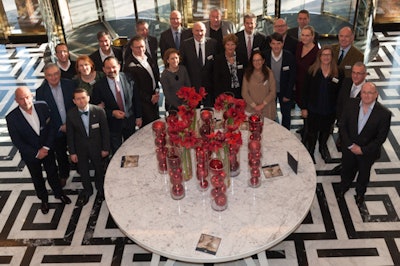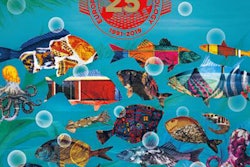
The long wait is nearly over: ECR 2017 gets underway on 1 March, and the excitement levels and feeling of anticipation are building, according to Dr. Paul Parizel, PhD. In the second part of our interview with the congress president, we offer a sneak preview into what you can expect to find in Vienna and how the meeting will differ from previous events.
AuntMinnieEurope.com: What's your broad vision for this year's congress?
Parizel: Radiology is currently undergoing a period of rapid change, and there is an increasing focus on functional, biological, and genetics-related imaging. The mainstay of radiology is still anatomical imaging, but now radiologists also have to provide information about cutting-edge techniques and help our clinical colleagues understand they should not be afraid of innovations. Rather, they should find a way to adopt these techniques to explore new diagnostic pathways and improve existing workflows.
Radiology is not only about detecting lesions and offering a differential diagnosis, but also about understanding how the human body works, how lesions arise and behave, and how we can monitor and influence disease processes using radiological techniques and image-guided interventions.
 The first meeting of the Program Planning Committee (PPC) for ECR 2017 took place at the Hotel Hilton Vienna Plaza. All images courtesy of the ESR.
The first meeting of the Program Planning Committee (PPC) for ECR 2017 took place at the Hotel Hilton Vienna Plaza. All images courtesy of the ESR.What's new this year compared with ECR 2016?
ECR 2017 will have a unique twist compared with previous editions because our meeting is specifically dedicated to youth. I invite everyone to take a stroll in "the flower gardens of radiology." Radiology is a beautiful, fragrant, sweet-smelling flower garden, and this is the message I want to bring to young radiologists throughout Europe and across the globe.
Our scientific program reflects this focus on a new generation of radiologists, who demand high-quality education, delivered in an efficient, understandable, and customer-friendly way. To accommodate these young colleagues, there will be more interactive sessions and a more prominent role for social media, and we shall have topics that are of interest to young people, because they are the future of our profession. The broad consensus among the members of the Program Planning Committee demonstrates our shared ambition for ECR 2017 to bring this message of hope to a new generation of radiologists.
In addition, this will be the first ECR that is recognized as the official annual scientific meeting in medical imaging for radiographers by both the European Federation of Radiographer Societies (EFRS) and the European Society of Radiology (ESR). A growing number of educational sessions and workshops have been planned especially for radiographers. The EFRS Workshop and the "EFRS meets Belgium" session will provide insight into the clinical work and research performed by radiographers. All of the sessions for radiographers taking place in Room K will be simultaneously translated into German, Italian, Polish, and Spanish.
In the ESR Meets sessions, you can discover the radiological flower gardens of Belgium, Peru, and the U.S. The topics will be emergency radiology (Belgium), Peru in the radiological world (Peru), and precision imaging and patient experience (U.S.).
It is reassuring to see the European Diploma in Radiology (EDiR) continues to grow in popularity and has become a standard of excellence for radiologists. EDiR will have a prominent place during ECR 2017. The diploma examination is fully booked, and candidates accepted for the EDiR examination who applied before 15 December also receive free congress registration.
There are so many other new aspects, of course, and I would urge everybody to study the full program on the ESR website. Also, make sure you use ECR Online. This portal is used by thousands of people to follow the ECR remotely. Also, during ECR you can use it to catch up with sessions you miss.
 The flowers in the 2017 poster are a metaphor for youth, spring, a new dawn, and a new generation in radiology.
The flowers in the 2017 poster are a metaphor for youth, spring, a new dawn, and a new generation in radiology.How was the congress poster created? What message does it convey to attendees?
The poster for ECR 2017 features a stylized skull covered in flowers. The skull contains the brain, and this symbol reflects my interest in neuroradiology; the colorful flowers are a metaphor for youth, spring, a new dawn, and a new generation in radiology.
With this eye-catching poster, I want to invite our colleagues to join me in exploring the beautiful and fragrant gardens of radiology.
Radiology is an adventure, a voyage of discovery. And radiologists are like gardeners, cultivating and creating beautiful flowers but also pruning the plants when necessary and weeding the flowerbeds. Presented like this, the analogy with diagnostic and interventional radiology should be obvious.
Which three congress sessions are you most looking forward to and why?
The opening ceremony, the honorary lectures, and the party, of course.
The honorary lectures will be presented by top speakers from the U.S. (Dr. Mauricio Castillo -- Wilhelm Conrad Röntgen Honorary Lecture), from the Netherlands (Dr. Mathias Prokop -- Josef Lissner Honorary Lecture), and from the U.K. (Dr. Fiona J. Gilbert -- Arthur de Schepper Honorary Lecture). In addition, we shall have a special guest lecturer from Brazil, who will provide us with information about the Zika virus infection (Dr. Maria de Fátima Vasco Aragão -- Breaking news from Latin America).
Do you feel optimistic about the likely attendance at the congress?
Based on the number of abstracts, I am very optimistic and positive. We received a record 6,757 abstracts, representing a 22.8% increase on last year's figure. This includes abstracts for both scientific papers and oral presentations (+18%), and electronic posters for the ECR's EPOS exhibition (+27%). The rise in submissions for EPOS reflects the great success of the Voice of EPOS sessions, introduced at ECR 2016, which give poster authors the opportunity to present their work in person.
In addition to abstracts from Europe, we received huge increases in submissions from Latin America (Argentina, Brazil, Mexico, Chile, and Colombia) and Asia (China, India). This is living proof that the outreach of ESR is now truly global. It demonstrates the appeal of participating in one of the world's biggest medical imaging events is as high as ever and that the future of radiology, and of the ECR, is secure.
The essence of the ECR remains the same, however: to provide a platform where high quality scientific and educational content goes hand in hand with professional contacts and networking. I hope that ECR 2017 will be remembered for the grand opening ceremony, the honorary lectures, the social events, and most of all for the spirit of friendship and conviviality.



















